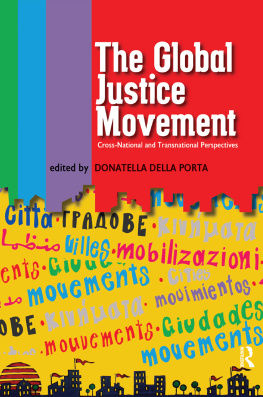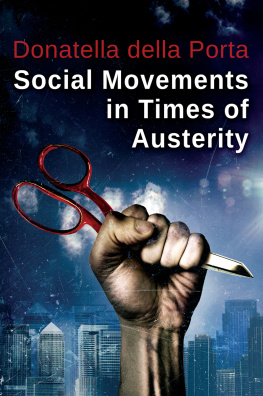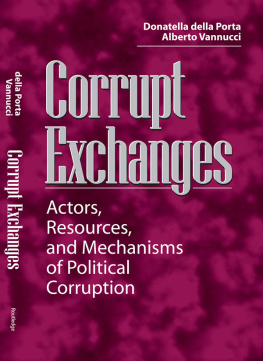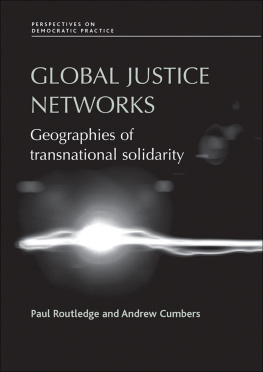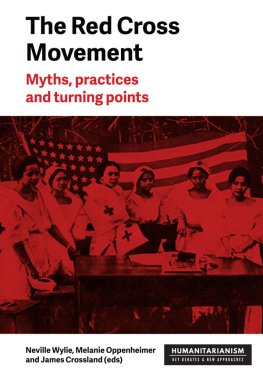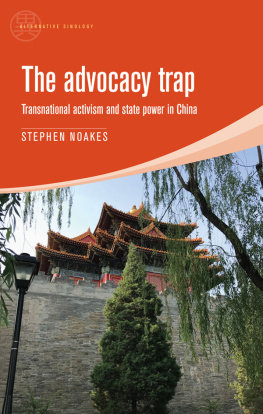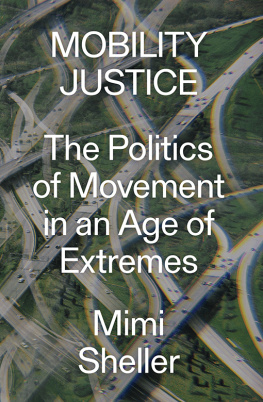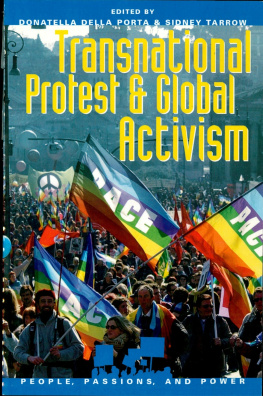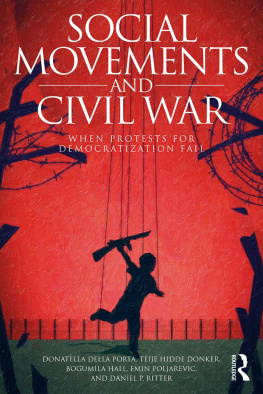THE GLOBAL JUSTICE MOVEMENT
THE GLOBAL JUSTICE MOVEMENT
Cross-national and Transnational Perspectives
edited by Donatella della Porta
First published 2007 by Paradigm Publishers
Published 2016 by Routledge
2 Park Square, Milton Park, Abingdon, Oxon OX14 4RN
711 Third Avenue, New York, NY 10017, USA
Routledge is an imprint of the Taylor & Francis Group, an informa business
Copyright 2007, Taylor & Francis.
All rights reserved. No part of this book may be reprinted or reproduced or utilised in any form or by any electronic, mechanical, or other means, now known or hereafter invented, including photocopying and recording, or in any information storage or retrieval system, without permission in writing from the publishers.
Notice:
Product or corporate names may be trademarks or registered trademarks, and are used only for identification and explanation without intent to infringe.
Library of Congress Cataloging-in-Publication Data
The global justice movement : cross-national and transnational perspectives / edited by Donatella della Porta.
p. cm.
Includes bibliographical references and index.
ISBN-13: 978-1-59451-304-6 (hc)
ISBN 10: 1-59451-304-X (hc)
1. Social movementsInternational Cooperation. 2. Protest movementsInternational cooperation. 3. Anti-globalization movementInternational cooperation. I. della Porta, Donatella, 1956. II. Title.
HM881.G553 2007
ISBN 13 : 978-1-59451-304-6 (hbk)
ISBN 13 : 978-1-59451-305-3 (pbk)
Designed and Typeset by Straight Creek Bookmakers.
Contents
Donatella della Porta |
Mario Pianta and Raffaele Marchetti |
Herbert Reiter (with Massimiliano Andretta, Donatella della Porta, and Lorenzo Mosca) |
Manuel Jimnez and ngel Calle |
Isabelle Sommier and Hlne Combes |
Christopher Rootes and Clare Saunders |
Dieter Rucht, Simon Teune, and Mundo Yang |
Nina Eggert and Marco Giugni |
Jennifer Hadden and Sidney Tarrow |
Donatella della Porta |
This book reports the first results of the comparative research project Democracy in Europe and the Mobilization of SocietyDemos (http://demos.iue.it). The Demos project is financed by the European Commission, 6th FP Priority 7, Citizens and Governance in a Knowledge Based Society, and (for the Swiss case) the Federal Office for Education and Science, Switzerland. It is coordinated by Donatella della Porta (European University Institute); partners are University of Kent at Canterbury, UK, Christopher C. Rootes; Wissenschaftszentrum Berlin fuer Sozialforschung, Germany, Dieter Rucht; Universit di Urbino, Italy, Mario Pianta; Centre de recherches politiques de la Sorbonne (CRPS), Universit Panthon-Sorbonne, France, Isabelle Sommier; Instituto de Estudios Sociales de Andalucia, Centro Superior de Investigaciones Cientificas (IESA-CSIC), Spain, Manuel Jimenez; and Laboratoire de recherches sociales et politiques appliquees (resop), Universite de Geneve, Switzerland, Marco Giugni. We are especially grateful for their time and their trust of the thousands of activists who helped our understanding of the global justice movement. We also wish to express our deep gratitude to Sidney Tarrow for his many suggestions, and to Sarah Tarrow, for a careful editing of the manuscript.
An Introduction
Donatella della Porta
The Global Justice Movement in Context
When some fifty thousand demonstrators protested against the third World Trade Organization (WTO) conference in Seattle in November 1999, social scientists still focused on explaining the institutionalization of social movements. Only gradually did intense international mobilizationin counter-summits, Global Days of Action, European Marches against Unemployment, Intergalactic Meetings of the Zapatistas, and World Social Forumsstart to build awareness of and interest in the emergence of a new cycle of protest. In subsequent years, hundreds of thousands marched against the International Monetary Fund (IMF) and World Bank meetings in Washington and Prague in 2000 and 2001 and against the European Union (EU) summits in Amsterdam in 1997, Nice in 2000, and Gothenburg in 2001. They protested the World Economic Forum in yearly demonstrations in Davos, the G8 summit in Genoa in 2001, and (following the call issued by the first European Social Forum) the Iraq war in hundreds of cities on February 15, 2003.
That cycles of protest emerge unexpectedly is certainly not new. On the eve of 1968, social scientists and politicians alike lamented the end of ideologies, the institutionalization of the labor movement and consumption society, and, above all, the decline of interest in politics. At the turn of the millennium, the debate focused on the disappearance of a sense of community, the institutionalization of the new social movement, the antipolitical stance of new generations. Surely, the emergence of a new cycle testifies to a rupture in the prevailing forms of collective action and organizational strategy as well as collective identities. In this sense, the perception of a sudden break reflects the challenges that cycles of protest pose to existing repertoires of collective action. During protest cycles, new organizational structures emerge with new styles of activism (Tarrow 1989; della Porta 2005a). What seemed established is once again in movement.
Waves of protest do not, however, emerge from nowhere. In the sociology of social movements, various concepts have been used to depict movement survival beyond protest mobilization: Melucci (1996) described the alternate stages of visibility and latency; Verta Taylor (1989) analyzed the functioning of organizations in periods of movement doldrums. It was observed that, even in low ebbs, social movement organizations do not invariably transform themselves into interest groups or charities (della Porta 2003a and 2003b). Social movement organizations from previous waves of mobilization often participate in the rise of new cycles of protest, ensuring continuity with the past.
Although often unexpected, the emergence of a protest cycle is not as sudden as it appears. Protest requires existing organizational structures able to mobilize resources, as well as less visible processes of networking and construction of justifications for collective action. It involves institutional actors and arenas: For instance, in some countries, the 1968 movements also developed inside student unions as well as in parties structures (Tarrow 1989). The emerging movements are often influenced by the characteristics of the organizations that host them in their infancy, and their evolution is the product of a mix of traditions and challenges to those traditions. The perception of a sudden rupture is in part an outcome of the natural conformism in the social sciences, where the confirmation of general trends (such as the bureaucratization of labor unions or the institutionalization of social movement organizations) is often facilitated by the choice of some objects of study (such as the union leadership or the more visible and better structured nongovernmental organizations [NGOs]) and not others. Conversely, the singling out of countertrends seems to be discouraged by their lack of visibility or relevance within the dominant paradigm.


